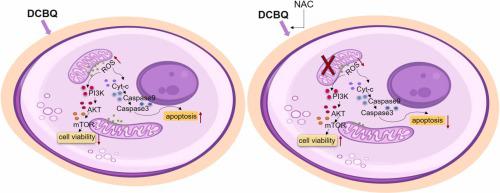Ecotoxicology and Environmental Safety ( IF 6.2 ) Pub Date : 2023-08-18 , DOI: 10.1016/j.ecoenv.2023.115357 Ting Liu 1 , Xin Chen 2 , Wanling Li 3 , Xu Zhang 2 , Gaihua Wang 2 , Jun Wang 2 , Lanqian Liang 2 , Fan Yang 2 , Juan Li 2 , Jinhua Li 2

|
2,6-dichloro-1,4-benzoquinone (DCBQ) has been identified as an emerging disinfection byproducts (DBPs) in drinking water and has the potential to induce neurodevelopmental toxicity. However, there is rarely a comprehensive toxicological evaluation of the neurodevelopmental toxicity of DCBQ. Here, neural differentiating SH-SY5Y cells were used as an in vitro model. Our results have found that DCBQ has decreased cell viability and neural differentiation, generated higher level of reactive oxygen species (ROS), increased the percentage of apoptosis and lowered the level of mitochondrial membrane potential, suggesting the neurodevelopmental toxicity of DCBQ. In addition, antioxidant N-acetyl-L-cysteine (NAC) could significantly attenuate these DCBQ-induced neurotoxic effects, supporting our hypothesis that the neurodevelopmental toxicity may be related with oxidative stress induced by DCBQ. We further demonstrated that DCBQ-induced neurodevelopmental toxicity could promote the mitochondrial apoptosis pathway and inhibit the prosurvival PI3K/AKT/mTOR pathway through inducing ROS, which ultimately inhibited cell proliferation and induced apoptosis in neural differentiating SH-SY5Y cells. These findings have provided novel insights into the risk of neurodevelopmental toxic effects associated with DCBQ exposure, emphasizing the importance of assessing the potential neurodevelopmental toxicity of DBPs.
中文翻译:

氧化应激是 2,6-二氯-1,4-苯醌诱导的神经发育毒性的关键事件
2,6-二氯-1,4-苯醌 (DCBQ) 已被确定为饮用水中新出现的消毒副产物 (DBP),并有可能诱发神经发育毒性。然而,很少对 DCBQ 的神经发育毒性进行全面的毒理学评价。在这里,神经分化 SH-SY5Y 细胞被用作体外模型。我们的结果发现,DCBQ 降低细胞活力和神经分化,产生更高水平的活性氧 (ROS),增加细胞凋亡百分比并降低线粒体膜电位水平,表明 DCBQ 具有神经发育毒性。此外,抗氧化剂N-乙酰-L-半胱氨酸(NAC)可以显着减弱DCBQ诱导的神经毒性作用,支持我们的假设,即神经发育毒性可能与DCBQ诱导的氧化应激有关。我们进一步证明,DCBQ 诱导的神经发育毒性可以促进线粒体凋亡途径,并通过诱导 ROS 抑制促存活 PI3K/AKT/mTOR 途径,最终抑制神经分化 SH-SY5Y 细胞的细胞增殖并诱导细胞凋亡。这些发现为与 DCBQ 暴露相关的神经发育毒性作用风险提供了新的见解,强调了评估 DBP 潜在神经发育毒性的重要性。

































 京公网安备 11010802027423号
京公网安备 11010802027423号